深化医药卫生体制改革.pdf
内蒙古党委办公厅 政府办公厅 印发《关于深化医药卫生体制改革五项重点工作2011年实施方案》的通知 内
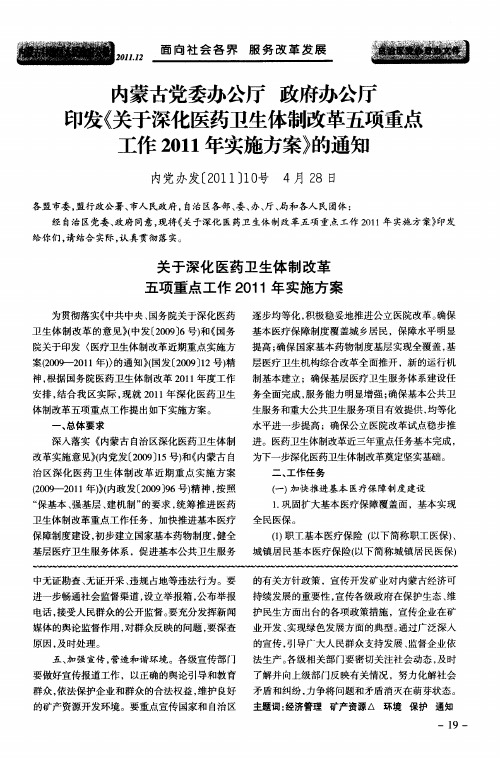
原 因 , 时处理 支持 发展 、 督企业 依 监
农 民工等人员选择性参保的政策。人力资源和社 起付线 ,政策范围内住 院自 ( 付费用救助比例原则
会保 障厅 、 育厅 、 教 国资委 、 政厅 负责) 财
上不低于 5 %。 0 探索开展特重大疾病救助试点。 鼓
() 一 步巩 固新 型农 村 牧 区合 作 医疗 ( 2进 以下 励社 会力 量 向医疗救 助慈善捐 赠 , 宽筹 资渠道 。 拓 简称 新 农合 ) 盖 面 , 合 率 继 续稳 定 在 9 % 以 ( 覆 参 0 民政厅 、 生厅 、 卫 人力资源和社会 保障厅负责)
经 自治区党委、 政府同意, 现将《 关于深化 医药卫生体制改革五项重点工作 21 年实施方案》 01 印发
给 你们 , 结合 实际 , 真贯彻 落 实。 请 认
关于深化 医药卫生体 制改革 五项重 点工作 2 1 0 1年实施 方案
为贯彻落 实《 中共 中央 、 国务院关于 深化 医药 逐 步均等化 , 积极稳 妥地推进 公立 医院改革 。 确保
一
1 — 9
2 ¨ 2
堡 零
堆
参保 人数达 到 90万人 , 保率 均提 高 到 9 %以 予 必要 支持 的政 策措施 。( 厅 、 0 参 0 卫生 人力 资源和社
上。妥善解决关闭破产企业退休人员和困难企业 会 保障 厅、 民政 厅 、 财政 厅 负责 )
卫生体制改革的意见》中发(096号) 国务 基本 医疗保 障制度覆 盖城 乡居 民 ,保障水平 明显 ( 20 ) 和《
医药卫生体制改革:不断深化稳步推进 成效显现
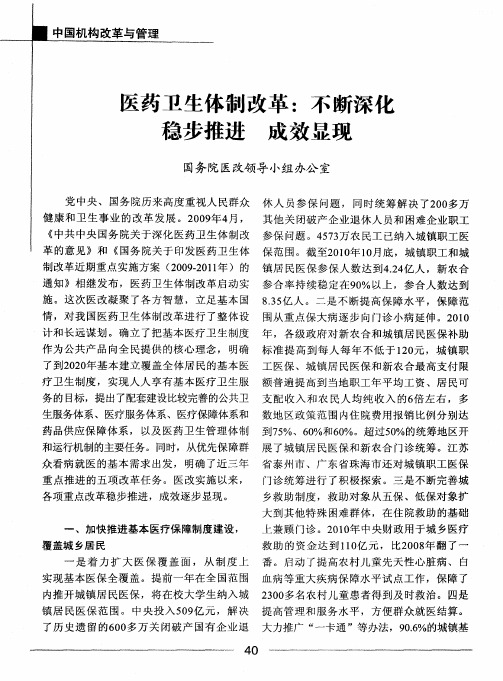
医药 卫生 稳步
国务
党 中央 、国务 院历 来高度 重视/ ^ 健 康 和卫 生事 业 的改 革发 展 。2 0 j 0 9, 《 中共 中央 国务 院关于深化 医药卫 生
堇 的 音 四. 和 围 落 陴 - 印 悖 T-
多 万
职 工 工 医
0 个省 ( 区、市 )完 成 了基
员 编 制 标 准 的 核 定 ,超 过
生机 构实 行 了 岗位聘 用 , ( 、市 )均 已完 成公共 区 匣 生事业 单位绩 效工 资实施 [ 资正逐 步兑现 到位 。绝大
士n 桷 山 qi :l门 公 I 弗 阳
天津 、重庆 、宁夏等 地在提 高基本 医保 统筹 除西 层 次 、城 乡统筹等 方面进 行 了积 极探索 。广 卫 生 东省湛江 市 、河 南省 洛 阳市等地还 探索 委托 意见 商业 健康 保险公司经办基本医保业务 。 二、稳步推进 国家基本 药物制度实施 , 取得初步成效
了 ̄ 2 2 年 基 本 建 立 覆 盖 全 体 居 民 的 基 本 医 工 医 保 、城 镇 居 民 医 保 和 新 农 合 最 高 支 付 限 10 0 J
疗卫生制度 ,实现 人人 享有基 本医疗卫 生服 额 普 遍 提 高 到 当地 职 工 年 平 均 工 资 、 居 民可 务的 目标,提 出了配套建设比较完善的公共卫 支 配 收 入 和 农 民 人 均 纯 收 入 的6 左 右 , 多 倍
遴选 、采购 、配备 使用 以及 医保报销 等各个
一
环 节 进 行 了 整 体 设 计 , 明 确 基 本 药 物 制 度 首 卫生机 构标准 化建 设 ,发挥县 级 医院在农村 先 在 基 层 实 施 。二 是 逐 项 细 化 和 落 实 关 键 环 三 级 医疗卫 生服务 网络 中 的龙 头作用 。近两 节 。 发 布 《 0 9 国 家 基 本 药 物 目录 ( 20版 基 年 , 国 家 发 展 和 改 革 委 员 会 累 计 安 排 资 金 层 版 ) 》 , 针 对 基 层 常 见 病 、 多 发 病 确 定 4 0 元 ,支 持 1 7 所 县 级 医 院 、5 6 所 中 0亿 87 19
湖北省人民政府办公厅关于进一步深化医药卫生体制改革试点工作的通知

。
推 进健 康 管理 服 务 和 协调督 导
省 发展 改革 委要 加 大 对试点 地方 信
;
资源下沉 息 化酿 和基 层 能力 建 设项 目 的支 持 力 度
:
省财
,
试点 地方
(
武汉市黄 陂 区
“
,
石首 市 SUT要督 促试点 地^m定 落实
。
医疗 SA
;
三)
开展
互 联 网 + 分级 诊 疗
。
基本设 施设 备 及服务 提供 机 构 等
,
。
探索
展深化 医 药卫 生体 制 改 革试 点 工 作
:
现 就有 关事
以 定额 收费 的 方式 提供 基 本 医 疗 服务
、
对农村 五
项通知 如 下 保对象
一
城镇特 困 供养 人 员
。
、
城 乡 孤儿 按 规定 实 落 实 试 点 县级 政府
郭兴才
武穴市 花桥镇小 学
李小锋襄 阳 市 樊城 区牛 首
中 石拥军 咸 宁市 咸安 区 大幕 乡 常收初级 中 学
谭金平兴 山 县 髙桥乡 中 心学 校李启 明 来凤县 三胡 乡 胡 家沟 中心 小学 郭生文
洪湖市 峰 口 镇朱市 中 心 小学
蒋宏华
江汉油 田 教育集 团 龙 尾 山 学校
切实 推进健康湖 北 建设
体制改革
〔2 0 1 6 〕
20 16
年重点 工作 任 务 的 通知 等有 关要 求
,
》
(
国 办 发 二
、
试 点 内 容及地 区
)
26
号
)
上海卫生年鉴pdf
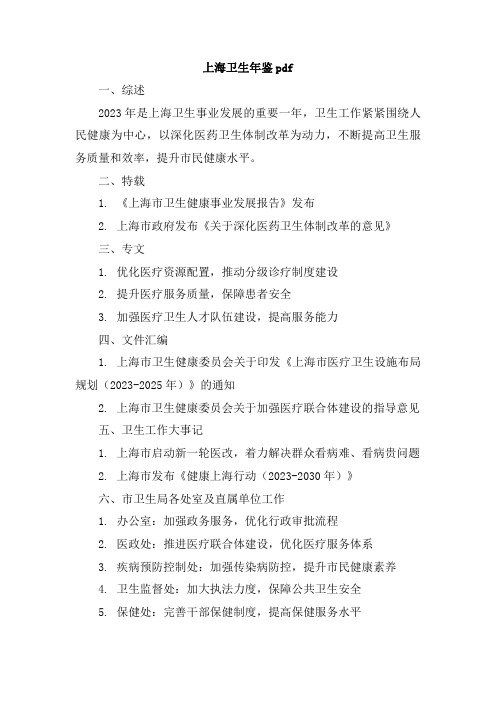
上海卫生年鉴pdf一、综述2023年是上海卫生事业发展的重要一年,卫生工作紧紧围绕人民健康为中心,以深化医药卫生体制改革为动力,不断提高卫生服务质量和效率,提升市民健康水平。
二、特载1.《上海市卫生健康事业发展报告》发布2.上海市政府发布《关于深化医药卫生体制改革的意见》三、专文1.优化医疗资源配置,推动分级诊疗制度建设2.提升医疗服务质量,保障患者安全3.加强医疗卫生人才队伍建设,提高服务能力四、文件汇编1.上海市卫生健康委员会关于印发《上海市医疗卫生设施布局规划(2023-2025年)》的通知2.上海市卫生健康委员会关于加强医疗联合体建设的指导意见五、卫生工作大事记1.上海市启动新一轮医改,着力解决群众看病难、看病贵问题2.上海市发布《健康上海行动(2023-2030年)》六、市卫生局各处室及直属单位工作1.办公室:加强政务服务,优化行政审批流程2.医政处:推进医疗联合体建设,优化医疗服务体系3.疾病预防控制处:加强传染病防控,提升市民健康素养4.卫生监督处:加大执法力度,保障公共卫生安全5.保健处:完善干部保健制度,提高保健服务水平6.科教处:加强医学教育和科研,培养高素质医学人才7.中医药发展处:促进中医药传承创新发展,提高中医药服务能力8.规划财务处:加强卫生规划,优化财务管理9.人事处:加强人才队伍建设,优化人才结构10.直属单位:各单位紧密配合,全面推进卫生事业发展七、区卫生局和部分事业单位工作1.黄浦区卫生局:加强基层医疗服务,提高居民健康水平2.徐汇区卫生局:推进医疗改革,优化医疗资源配置3.长宁区卫生局:加强健康促进工作,提高居民健康素养4.静安区卫生局:完善公共卫生体系,保障居民健康权益。
国务院常务会议审议《关于深化医药卫生体制改革的意见》决定再次向社会公开征求意见

西医并重, 积极探 索政事分 开、 办 管 分 开、 药分 开、 利 性 和 非 营 利 性 医 营 内设 机 构 和人 员 编制 规 大事故的责任。 国务 院要 求, 各部 门 分 开 , 力 建 立协 调 统一 的 医药卫 生 部 主要 职 责 、 努 要 密切 协 同, 成 合 力 , 同做 好 食 形 共 已经国务院常务会议审议通过。 管理 体 制 、 高效 规 范 的 医 药卫 生机 构 定》 据介 绍 , 据 国务 院批 复 卫 生 部 品安 全监 管 工作 。 根 运 行 机 制 、 府 主 导 的 多元 卫 生投 入 政 ( 源: 来 新华社 上 海信息 网 ) 三定 ” 定 , 生 部 的 职 责、 规 卫 内设 机 制 、 学 合 理 的 医 药 价 格 形 成 机 的“ 科 食 品药 品监 督 管理 局将药 品受理 、 制 、 格 有 效 的 医 药卫 生监 管 体 制 、 机构 和人 员编 制主要 有 以 下调 整 : 严
国务 院常务 会议 审议
会议 强调 , 药卫 生 体 制 改 革 涉 调食 品安 全 、 织查 处 食 品安 全 重 大 医 组
加 并将 “ 生监 督 局 ” 卫 原 则 和 主 要 措 施 。 总 体 目标 是 , 到 医疗 卫 生机 构 经 费保 障机 制 , 强 队 本 药物 制 度 司”, 食 伍 建设 , 高服 务 水 平。 四是 促 进 基 调 整 为“ 品 安全 综 合 协调 与 卫 生监 提 22 0 0年 , 基本 建立覆 盖 城 乡居 民的 基 本 公 共 卫 生服 务 均 等 化 。 完 善 城 乡 督局 ” 同时增加 了部 分行政 编制 。 , 本 医疗卫 生 制度 , 包括 比较 完善 的 公 提 此外 , 明确 相 关 部 门在食 品安 全 共 卫 生服 务 体 系和 医疗服 务 体 系, 比 公 共 卫 生服 务体 系, 高服 务 效 率和 三 较 健 全 的 医疗保 障体 系, 比较 规 范 的 质 量 。五是 推 进公 立 医院改 革 试 点 。 监 管 方 面 的 职 责 分 工。 “ 定 ”明确 改革 公 立 医院管 理体 制 和 运行 机 制 , 规 定 , 生 部 牵头 建 立食 品 安全 综 合 卫 药品供 应 保 障体 系, 比较 科 学的 医疗 负责 食 品 安 全 综 合 监 督 ; 卫 生机 构 管 理体 制和 运 行 机 制 , 群 推进 结 构 调 整 和 合 理 布 局 。加 大政 协 调机 制 , 为 规 众提 供安 全 、 效 、 有 方便 、 价廉 的 医疗 府投 入 , 范 收 支 管理 。 改进 医院 内 农 业部 负责 农 产 品 生产 环 节 的监 管 ; 优 规 卫 生服 务 , 实现人 人 享 有基 本 医疗 卫 部 管理 , 化 服 务 流 程 , 范诊 疗 行 国 家质 量 监 督 检 验 检 疫 总局 负责 食 品 生 产 加 工 环 节 和 进 出 1食 品 安 全 : 7 生服 务 , 断提 高 人 民群 众 健 康 水 为 。 不
李斌:深化医药卫生体制改革(选摘)
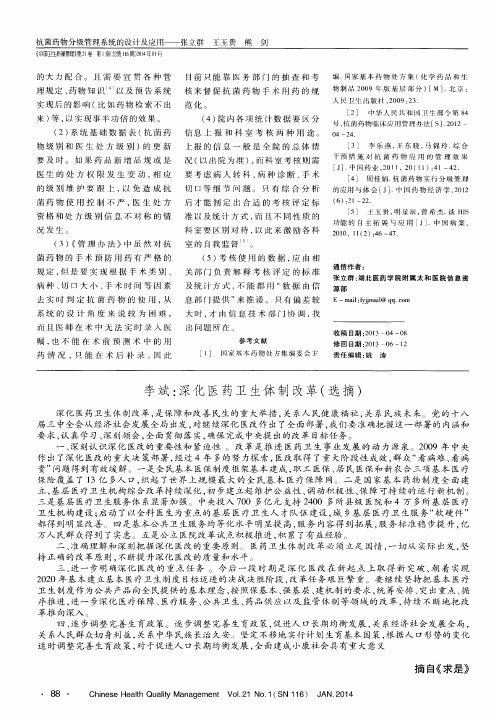
、
深 刻认识 深化 医改 的重要 性和 紧迫性 。 改革 是 推 进 医药卫 生事 业发 展 的动 力 源泉 。2 0 0 9年 中央
作 出 了深化 医改 的重 大决 策部 署 , 经过 4年 多的努 力探 索 , 医改取 得 了重 大阶段 性成 效 , 群众 “ 看病 难 、 看病 贵” 问题 得 到有 效缓 解。一是 全 民基本 医保制 度框 架基 本 建成 , 职 工 医保 、 居 民 医保 和 新农 合三 项基 本 医疗 保 险覆 盖 了 1 3亿 多人 口, 织起 了世 界 上规 模 最 大 的 全 民基 本 医疗保 障 网。二 是 国家基 本 药 物 制度 全 面 建 立, 基 层 医疗卫 生机 构综合 改革持 续 深化 , 初 步 建立起 维 护公 益性 、 调 动积 极 性 、 保 障可持 续的运 行 新机 制 。 三是基 层 医疗卫 生服 务体 系显 著加 强。 中央投入 7 0 0多亿 元 支持 2 4 0 0多所县 级 医院和 4万 多所基 层 医疗 卫 生机 构 建设 ; 启动 了以全 科 医生为 重点 的基 层 医疗卫 生 人 才 队伍 建设 , 城 乡基 层 医疗 卫 生服 务“ 软硬件” 都得 到明 显改善 四是基本 公共 卫 生服 务 均等化 水平 明 显提 高 , 服 务 内容 得 到拓展 , 服 务标 准稳 步提 升 , 亿 万人 民群 众得到 了实惠 。五是公 立 医院改 革试 点积极推 进 , 积 累 了有 益经验 。 二、 准 确理 解和 深刻把 握深 化 医改的 重要 原 则 医药卫 生体 制改 革 必须 立足 国情 , 一切 从 实际 出发 , 坚 持 正 确的 改革原 则 , 不断提 升深 化 医改的质 量和 水平 。 三、 进 一 步明确 深化 医改 的 重点 任 务 。今 后 一 段 时期是 深 化 医改 在 新起 点 上 取得 新 突破 、 朝 着 实现 2 0 2 0年基 本建 立基 本 医疗卫 生制度 目标 迈进 的决战 决胜 阶段 , 改革任 务 艰 巨繁 重。要 继 续 坚持把 基 本 医疗 卫 生制度 作 为公 共 产品 向全 民提 供 的基本 理念 , 按 照保 基 本 、 强基层 、 建机 制的要 求 , 统筹安排 、 突 出重点 、 循 序推 进 , 进 一 步深化 医疗保 障 、 医疗服 务 、 公 共 卫生 、 药品供 应 以及 监 管体 制 等领 域 的改 革 , 持 续 不 断地把 改
各方对《关于深化医药卫生体制改革的意见(征求意见稿)》的意见(综述1)——完善政府筹资职能为新医

nv ̄ U,S a g a 2 0 3 i i e h n h i 0 0 2,C ia hn )
【 btat I sm a f pn n o ul ,Onidw egvrm n’ nt n , seil t — A s c】 n u m I o oii srm pbi t a o nt oe etS uco s epc y h f r T o f c l h n f i l a ei
Eq a ia in ul t z o
改革 开 放 至今 , 国卫 生 总 费用 并 未 突 破 社 会 平 均 我
支付 能力 , 然而围绕“ 看病贵 ” 问题 的社 会反响却愈演 等
愈烈 , 医疗 服 务 供 、 和 组 织 三 方 处 于 严 重 的失 衡 状 需 况 。在 卫 生 费用 快 速 增 长 中需 方 个 人 承 担 了所 有 负
L u, HN VJn C A G
一 u, I i 一 g H OM R s r stto el e l m n S a ge, ua - s i L Xa 凡 , A o( e ac I tu h o e h n i efH at D v o et t t i F d nU h ep re s
【 e od 】 T e nni nt n vrm n; el sr c ss m; ul el r c s m; K yw rs h ac g u c os f oe et H ahi ua e yt P bi hahs v es t i f n f i og n tn n e c t ei ye
n n igf n t n i h r ca e ft e me ia eom .Tof li h n n i gf n t n a d srn t n te g v r— a cn u ci ste cu ilk y o h dc lrf r o ufl tef a cn u ci n te ghe h o en l i o me t uy i h rc s fme ia evc r e eomain b t ly v r mp ra oei heme ia eom , n gd t n te po e so d c ls r ie mak trfr to oh pa e yi otntrl n t dc rfr l n lo i h o sr t fh at is rn e s se a d p b i e lh s r ie s se a d as n te c n t cin o e l n u a c y tm n u lch at evc y tm. u o h
国办发〔2015〕34号《国务院关于深化医药卫生体制改革2014年工作和2015年重点工作任务的通知》总结

国务院办公厅关于印发深化医药卫生体制改革2014年工作总结和2015年重点工作任务的通知国办发〔2015〕34号各省、自治区、直辖市人民政府,国务院有关部门:《深化医药卫生体制改革2014年工作总结和2015年重点工作任务》已经国务院同意,现印发给你们,请结合实际,认真组织实施。
国务院办公厅2015年4月26日深化医药卫生体制改革2014年工作总结和2015年重点工作任务一、深化医药卫生体制改革2014年工作总结2014年是贯彻落实党的十八届三中全会精神、全面深化改革的开局之年,也是深化医药卫生体制改革的关键之年。
各地区、各有关部门坚决贯彻落实党中央、国务院的决策部署,坚持保基本、强基层、建机制,突出医疗、医保、医药三医联动,上下联动,内外联动,区域联动,统筹推进相关领域改革,着力用中国式办法破解医改这个世界性难题,取得新的进展和成效。
(一)综合施力,多方保障,形成医改工作合力。
党中央、国务院高度重视医改工作。
习近平总书记要求立足中国实际,借鉴国际先进经验,努力破解医改难题,强调没有全民健康,就没有全面小康,指出要推动医疗卫生工作重心下移、医疗卫生资源下沉,为群众提供安全有效方便价廉的公共卫生和基本医疗服务。
李克强总理多次主持召开国务院常务会议研究医改工作,并多次作出重要指示批示,强调要进一步树立基本医疗卫生制度是公共产品的理念,切实履行政府办医责任,注重发挥市场作用,有序放宽社会力量办医准入,推动医改向纵深发展,使人民群众得实惠、医务人员受鼓舞、资金保障可持续。
刘延东副总理主持国务院深化医药卫生体制改革领导小组会议及专题会议研究部署医改重点工作。
1.加强医改组织领导。
国家层面强化顶层设计,加强与省级深化医药卫生体制改革领导小组、国务院深化医药卫生体制改革领导小组各成员单位的统筹协调。
医改领导体制进一步理顺,各地医改机构和人员调整逐步到位,各成员单位各司其职,协作配合,加大了对医改工作的协调推进力度。
西藏自治区人民政府办公厅关于印发西藏自治区深化医药卫生体制改

年 深化 医
职 工基 本 医疗 保 险 以下 简 称 职工 医保
、 城
认 真 贯 彻 落 实 中 央 第 五 次 西 藏 工 作 座谈 会 精 神 , 按照藏党发 「 」 号 文件 部 署 , 以建 设 有 中
镇 居 民基本 医疗 保 险 以下 简 称 城 镇 居 民医 保 参 保人 数 达 到 料 万人 , 其 中城 镇 职 工 医保 参 保 人 数
你们 , 请结 合实 际 ,认 真组 织实 施 。
西藏 自治区深化医药卫生 体制改革
为 认 真 贯 彻 落 实 《中共 西 藏 自治 区 委员 会 西
藏 自治 区 人 民政 府 关 于 深 化 医 药 卫 生 体 制 改革 的
年重点工作方案
坚 持 以 预 防 为主 、 以农 牧 区 为 重 点 、 藏 中 西 医并
点 做好 农 民工 、 非 公 有 制 经 济组 织 从 业 人 员 、 灵活件
就业人员 、 关闭破产企业退休人员 、 困难企业职工 、
学生 以及寺庙僧尼参保工作 。 人 力资源社会保 障 厅、 卫生厅 负责 继续保持农牧 区医疗制度全覆盖 , 进一步提 高农牧 区医疗制度统筹层次 , 实现地 市 级统筹 。
于印发深化 医药卫生体制改革
排 的通 知 》 国 办 发 「 」 号 、
年主要工作安
年 全 国 医改
工 作 会议 精 神 和 国务 院医 改办 与 我 区签 订 的 《 深化 医药 卫生体 制 改革 年 度主要 工作 任务 责任
加 大 宣 传 力 度 , 确 保 改革 持 续 有 效 推 进 , 以优 异 成
万人 。 职工
国特 色 、西 藏 特 点 的 医 药 卫 生制 度 为 目标 , 坚 持 把 基 本 医 疗 卫 生 制 度 作 为 公 共 产 品 向全 民 提 供 的 核
国务院印发十三五深化医药卫生体制改革规划
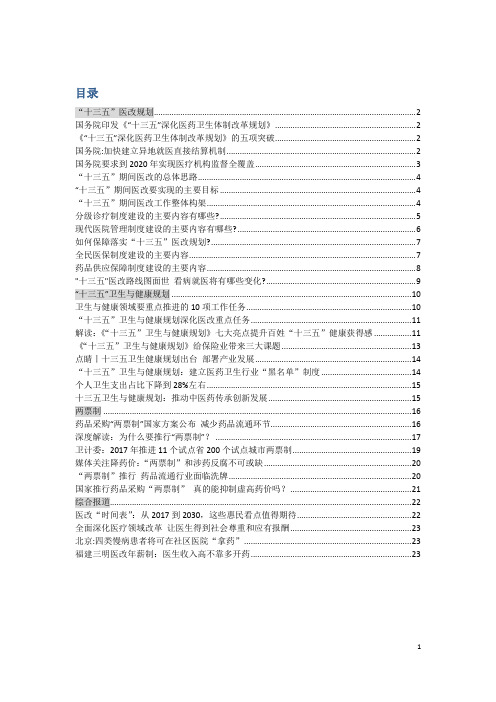
目录“十三五”医改规划 (2)国务院印发《“十三五”深化医药卫生体制改革规划》 (2)《“十三五”深化医药卫生体制改革规划》的五项突破 (2)国务院:加快建立异地就医直接结算机制 (2)国务院要求到2020年实现医疗机构监督全覆盖 (3)“十三五”期间医改的总体思路 (4)“十三五”期间医改要实现的主要目标 (4)“十三五”期间医改工作整体构架 (4)分级诊疗制度建设的主要内容有哪些? (5)现代医院管理制度建设的主要内容有哪些? (6)如何保障落实“十三五”医改规划? (7)全民医保制度建设的主要内容 (7)药品供应保障制度建设的主要内容 (8)"十三五"医改路线图面世看病就医将有哪些变化? (9)“十三五”卫生与健康规划 (10)卫生与健康领域要重点推进的10项工作任务 (10)“十三五”卫生与健康规划深化医改重点任务 (11)解读:《“十三五”卫生与健康规划》七大亮点提升百姓“十三五”健康获得感 (11)《“十三五”卫生与健康规划》给保险业带来三大课题 (13)点睛丨十三五卫生健康规划出台部署产业发展 (14)“十三五”卫生与健康规划:建立医药卫生行业“黑名单”制度 (14)个人卫生支出占比下降到28%左右 (15)十三五卫生与健康规划:推动中医药传承创新发展 (15)两票制 (16)药品采购“两票制”国家方案公布减少药品流通环节 (16)深度解读:为什么要推行“两票制”? (17)卫计委:2017年推进11个试点省200个试点城市两票制 (19)媒体关注降药价:“两票制”和涉药反腐不可或缺 (20)“两票制”推行药品流通行业面临洗牌 (20)国家推行药品采购“两票制”真的能抑制虚高药价吗? (21)综合报道 (22)医改“时间表”:从2017到2030,这些惠民看点值得期待 (22)全面深化医疗领域改革让医生得到社会尊重和应有报酬 (23)北京:四类慢病患者将可在社区医院“拿药” (23)福建三明医改年薪制:医生收入高不靠多开药 (23)“十三五”医改规划国务院印发《“十三五”深化医药卫生体制改革规划》1月9日,李克强总理签批,国务院日前印发《“十三五”深化医药卫生体制改革规划》(以下简称《规划》),部署加快建立符合国情的基本医疗卫生制度,推进医药卫生治理体系和治理能力现代化。
深化医药卫生体制改革加快“健康山西”建设
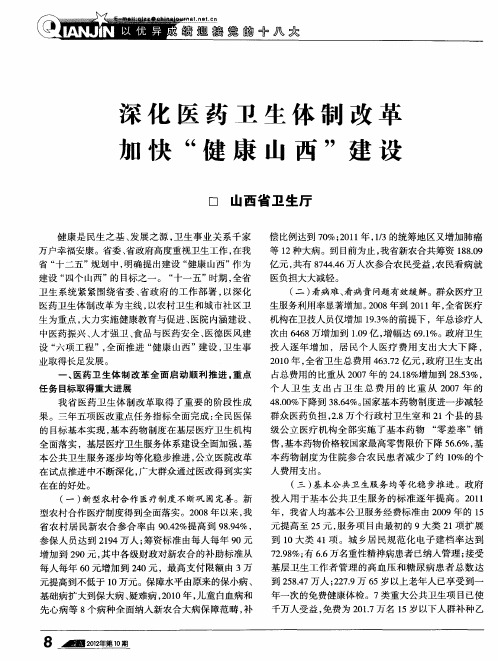
8
2 ̄ l o o 1 2
肝疫 苗 ;免 费为 42万 名贫 困 白内障患 者 实施 复 明手 . 术 ;58万 名农 村 孕产 妇住 院分 娩得 到 补 助 ;免 费 为 6. 4 .7万 名适 龄 农村 妇 女进 行 了宫颈 癌 、 腺 癌筛 查 。 27 乳 公 共 卫生 服务 体系进 一 步健全 。 0 8年至 2 1 年 , 20 0 1 全
生 为重 点 , 大力 实 施健 康 教育 与促 进 、 医院 内涵 建设 、
中医药振兴 、 人才强卫 、 品与医药安全 、 食 医德医风建 设“ 六项工程”, 全面推进 “ 健康 山西 ” 建设 , 卫生事
业取 得 长足发 展 。
一
次由 6 6 万增加到 1 9 , 48 . 亿 增幅达 6. 0 91 %。政府卫生
服 务 中心 建设 成 为首 批 全 国示 范社 区卫生 服 务机 构 。 社 区卫 生 服务 中 心在 城 市 大 医 院与 基 层 医 院 分诊 转 诊 制度 中发挥 了重 要 的作用 。 ( ) 三 医疗 卫 生资 源 配置趋 于合理 。省 政 府 投资 近 2 元 , 成 了山西 历史 上政 府 投 资最 多 、 0亿 建 规模 最 大 、 能最 全 、 准 最 高 的现 代 化 综 合 性 医院— — 山 功 标 西 大 医院 。 同时 , 忻州 、 汾 、 同 、 城 、 临 大 晋 运城 等 市新 建 和改 扩建 了一批 高 水 平 、现代 化 的市 级 综合 医院 ,
投 入 逐 年 增 加 ,居 民个 人 医疗 费 用 支 出大 大 下 降 , 21 , 0 0年 全省 卫 生 总费 用 4 3 2亿 元 , 府 卫 生支 出 6. 7 政 占总 费用 的 比重从 20 07年 的 2 .8 加 到 2 .3 41%增 85 %, 个 人 卫 生 支 出 占 卫 生 总 费 用 的 比 重 从 20 0 7年 的 4 .0 降 到 3. %。 8 %下 0 8 4 国家基本 药物 制度进 一 步减 轻 6 群众 医药 负 担 ,. 个行 政 村卫 生 室 和 2 个 县 的 县 28万 1
国发〔2012〕11号 国务院关于印发“十二五”期间深化医药卫生体制改革规划暨实施方案的通知

国务院关于印发“十二五”期间深化医药卫生体制改革规划暨实施方案的通知国发〔2012〕11号各省、自治区、直辖市人民政府,国务院各部委、各直属机构:现将《“十二五”期间深化医药卫生体制改革规划暨实施方案》印发给你们,请认真贯彻执行。
国务院二○一二年三月十四日“十二五”期间深化医药卫生体制改革规划暨实施方案深化医药卫生体制改革是贯彻落实科学发展观、加快转变经济发展方式的重大实践,是建设现代国家、保障和改善民生、促进社会公平正义的重要举措,是贯穿经济社会领域的一场综合改革。
“十二五”时期是深化医药卫生体制改革的攻坚阶段,也是建立基本医疗卫生制度的关键时期。
为巩固扩大前一阶段改革成果,实现2020年人人享有基本医疗卫生服务的既定目标,根据《中华人民共和国国民经济和社会发展第十二个五年规划纲要》和《中共中央国务院关于深化医药卫生体制改革的意见》(中发〔2009〕6号),编制本规划。
本规划主要明确2012-2015年医药卫生体制改革的阶段目标、改革重点和主要任务,是未来四年深化医药卫生体制改革的指导性文件。
一、规划背景自2009年4月深化医药卫生体制改革启动实施以来,在党中央、国务院领导下,各地区、各有关部门认真贯彻落实中央的决策部署,按照保基本、强基层、建机制的基本原则,完善政策、健全制度、加大投入,统筹推进五项重点改革,取得了明显进展和初步成效,实现了阶段性目标。
覆盖城乡全体居民的基本医疗保障制度(以下简称基本医保)框架初步形成,职工基本医疗保险(以下简称职工医保)、城镇居民基本医疗保险(以下简称城镇居民医保)和新型农村合作医疗(以下简称新农合)参保人数达到13亿人,筹资和保障水平明显提高,保障范围从大病延伸到门诊小病,城乡医疗救助力度不断加大。
国家基本药物制度初步建立,政府办基层医疗卫生机构全部实施基本药物零差率销售,药品安全保障得到明显加强;以破除“以药补医”机制为核心的基层医疗卫生机构综合改革同步推进,开始形成维护公益性、调动积极性、保障可持续的新机制。
中共中央国务院新新关于深化医药卫生体制改革的意见-参考译文
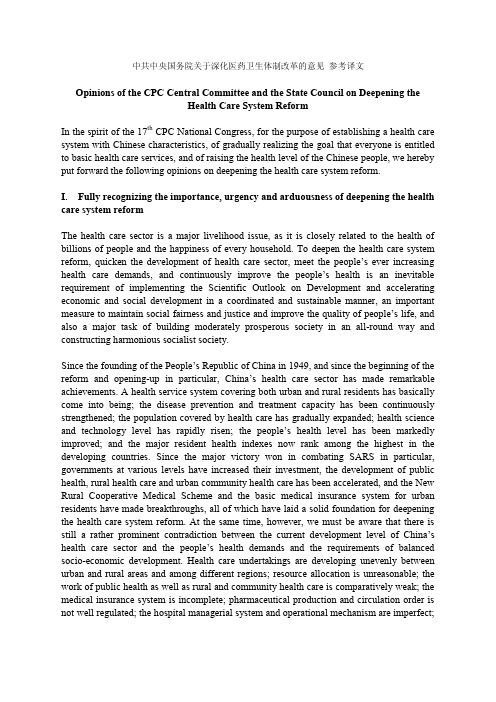
中共中央国务院关于深化医药卫生体制改革的意见参考译文Opinions of the CPC Central Committee and the State Council on Deepening theHealth Care System ReformIn the spirit of the 17th CPC National Congress, for the purpose of establishing a health care system with Chinese characteristics, of gradually realizing the goal that everyone is entitled to basic health care services, and of raising the health level of the Chinese people, we hereby put forward the following opinions on deepening the health care system reform.I.Fully recognizing the importance, urgency and arduousness of deepening the health care system reformThe health care sector is a major livelihood issue, as it is closely related to the health of billions of people and the happiness of every household. To deepen the health care system reform, quicken the development of health care sector, meet the people’s ever increasing health care demands, and continuously improve the people’s health is an inevitable requirement of implementing the Scientific Outlook on Development and accelerating economic and social development in a coordinated and sustainable manner, an important measure to maintain social fairness and justice and improve the quality of people’s life, and also a major task of building moderately prosperous society in an all-round way and constructing harmonious socialist society.Since the founding of the People’s Republic of China in 1949, and since the beginning of the reform and opening-up in particular, China’s health care sector has made remarka ble achievements. A health service system covering both urban and rural residents has basically come into being; the disease prevention and treatment capacity has been continuously strengthened; the population covered by health care has gradually expanded; health science and technology level has rapidly risen; the people’s health level has been markedly improved; and the major resident health indexes now rank among the highest in the developing countries. Since the major victory won in combating SARS in particular, governments at various levels have increased their investment, the development of public health, rural health care and urban community health care has been accelerated, and the New Rural Cooperative Medical Scheme and the basic medical insurance system for urban residents have made breakthroughs, all of which have laid a solid foundation for deepening the health care system reform. At the same time, however, we must be aware that there is still a rather prominent contradiction between the current d evelopment level of China’s health care sector and the people’s health demands and the requirements of balanced socio-economic development. Health care undertakings are developing unevenly between urban and rural areas and among different regions; resource allocation is unreasonable; the work of public health as well as rural and community health care is comparatively weak; the medical insurance system is incomplete; pharmaceutical production and circulation order is not well regulated; the hospital managerial system and operational mechanism are imperfect;government investment in health is insufficient; medical costs are soaring, individual burden is too heavy, and therefore, the people’s reaction is very strong.Featuring arduous health care tasks, the period from now to 2020 is crucial for China to build moderately prosperous society in an all-round way. Along with economic development and improvement of people’s living standards, the people will make higher demands on bettering health care services. Industrialization, urbanization, population aging, disease spectrum change, eco-environmental change and other factors pose a series of new and serious challenges to the health care work. To deepen the health care system reform is a strategic choice to accelerate the development of health care undertakings, an important channel to realize the goal of enabling people to share the achievements of reform and development, and an urgent aspiration of the broad masses of the people.Deepening the health care system reform is a difficult social systemic project involving broad aspects. China has a large population, low per capita income, significant urban-rural and regional disparities, and will be at the primary stage of socialism for a long period of time. These basic national conditions determine that the task of deepening the health care system reform is extremely complicated and arduous, and that it will be a gradual process. Therefore, only through long and arduous endeavors and perseverant explorations on the basis of specified directions and framework can we progressively establish a health care system in line with the country’s actual national conditions. To ensure the reform proceed smoothly and reach the expected goals, not only the reform should be pushed forward with firm determination, but also the work be well organized and steadily implemented.II.The guidelines, basic principles and overall goal of deepening the health care system reform(i)The guidelines for deepening the health care system reform It should be guided by the important thoughts of Deng Xiaoping theory and Three Represents; it should implement in depth the Scientific Outlook on Development; it should proceed from China’s national conditions, and draw on the useful international experience; it should aim at achieving the goal of ensuring basic health care services for everyone, and emphatically address the problems concerning the most direct and real interests of the people or the ones that the people are most concerned about. It should adhere to the commonweal nature of public health care; it should adhere to the policy of regarding prevention as the main task and the rural areas as the focal point, and of laying equal stress on traditional Chinese medicine (TCM) and western medicine; it should implement separation between government agencies and public institutions, between government administration and business operations, between medical and pharmaceutical services, and between profit and non-profit; it should strengthen government responsibility and investment, improve national health policies, perfect institutional systems, enhance supervision and regulation, promote institutional innovations, and encourage social participation, so as to construct a basic health care system covering urban and rural residents, continuously raise the health level of the entire population, and promote social harmony.(ii) The principles for deepening the health care system reform The health care system reform must be firmly based on the count ry’s basic conditions and proceed from reality, adhere to the right reform principles.- We should adhere to the people-first principle and attach primary importance to safeguarding the rights and interests of the people’s health. We should adhere to th e tenet of serving the people’s health with health care undertakings; regard safeguarding the people’s health as the center, and take the entitlement of basic health care services to everyone as the fundamental aim and outcome; make sure that the principle of commonweal nature be complied with throughout the entire process, from designing the reform program, establishing the health system, to constructing the health care service system; ensure that the basic health care system be public goods provided to the entire population; emphatically resolve the prominent problems to which people strongly react, and strive to achieve the goal of ensuring that health care services be available to the entire population.- We should adhere to finding a foothold in Chin a’s national conditions and build the health care system with Chinese characteristics. We should adhere to proceeding from the country’s basic conditions, sum up the practical experience of the reform and development of China’s health care undertakings by seeking truth from facts, and accurately identify the law of development and principal challenges of health care undertakings; adhere to ensuring that the basic health care service level is in coordination with the socio-economic development, and in conjunction with the affordability of the people; bring the role of TCM (including ethnic minority traditional medicine) into full play; adhere to positioning on local conditions, specifying guidance for different localities, giving full play to local initiatives, and exploring with the aim to establishing the basic health care system conforming to the country’s national conditions.- We should adhere to the unity of fairness and efficiency and combine government’s leading role with the role of market forces. We should intensify government’s responsibility in the basic health care system, strengthen governmental functions in institutionalization, planning, fund-raising, service provision, supervision and regulation, etc., safeguard the commonweal nature of public health care system, and advance fairness and justice. In addition, we should emphatically give full play to the role of market forces, call on social participation, promote the formation of orderly competition mechanism, upgrade operational efficiency, service level and quality of the health care system, and satisfy the people’s multi-layer and diversified demands for health care services.- We should adhere to overall planning and all-round consideration and combine resolving currently prominent problems with improving the institutional system. We should proceed from taking the overall situation into consideration, balance urban and rural development and development among different regions, reconcile the interests of the supplier, the customer and other stakeholders, emphasize the combination of prevention, treatment and rehabilitation, and appropriately handle the relationship among government, health careinstitutions, pharmaceutical enterprises, health care workers and the people. We should be far-sighted and engage in institutional innovations on the one hand, and focus on current situation and emphatically tackle the prominent problems of the health care system on the other hand; We should pay adequate attention to the overall design, clarify the overall reform direction, objective and basic framework on the one hand, and highlight the key points, conduct step-by-step implementation, and actively and prudently press ahead with the reform on the other hand.(iii) The overall goal of deepening the health care system Establish and improve the basic health care system covering urban and rural residents, and provide the people with secure, efficient, convenient and affordable health care services.By 2011, the basic medical security system shall have completely covered urban and rural residents, the essential medicines system shall have been preliminarily established, urban and rural grass-roots health care service system shall have been further strengthened, the basic public health services shall have been available far and wide, pilot projects for reforming state-owned hospitals shall have made breakthroughs, the accessibility to the basic health care services shall have been improved markedly, residents’ burden of medical costs shall be effectivel y reduced, and the problem of “difficult and costly access to health care services” shall have been remarkably relieved.By 2020, the basic health care system covering urban and rural residents shall have been fundamentally established. We shall have set up, across the country, a fairly complete public health service system and health care service system, a comparatively sound medical security system, a secured and relatively well regulated pharmaceutical supply system, a comparatively sound health care institution management and operational system, a multi-sponsored medical configuration shall be formed, everyone shall have access to the basic health care services, the multi-layer demands of the people for health care services shall be met preliminarily, and the health level of the people shall be further enhanced.III.Improving four major health care systems and establishing the basic health care system covering urban and rural residentsFour systems covering urban and rural residents shall be established, including the public health service system, health care service system, medical security system, and a secured pharmaceutical supply system, with an aim to forming a “four in one” basic health care system. The four systems shall be constructed in conjunction with each other, supplement each other and develop in a coordinated way.(iv) Strengthening the construction of the public health service system in an all-round way Efforts should be made to establish and improve professional public health service networks, which include diseases prevention and control, health education, maternity and child care, mental health, emergency treatment, blood collection and supply, hygiene supervision, family planning, and etc.; improve the public health service functions of thebasic health care service system, which is based on grass-roots health care service network; establish a public health service system featuring a clear-cut division of work, information-exchanging, resource-sharing, coordination and interaction; improve the capacity to deal with public health service and public health emergencies, and make equalized basic public health services gradually available to urban and rural residents.Efforts should be made to identify the scope of public health services. Clarify the national basic public health service items, and increase step by step the service contents. Encourage the local governments to increase, in accordance with the local economic development level and prominent public health problems, their public health service contents on the basis of the service items defined by the central government.Efforts should be made to improve the public health service system. Further clarify the functions, goal and tasks of the public health service system, optimize personnel and equipment configurations, and explore the effective means of integrating public health service resources. Perfect the major diseases prevention and control system as well as public health emergency mechanism, strengthen the surveillance, prevention and control of the diseases that severely threatening the people’s health, such as infectious diseases, chronic diseases, endemic diseases, occupational diseases, birth defects, and so on. And strengthen the construction of urban and rural first-aid system.Efforts should be made to strengthen health promotion and education. Health care institutions, government agencies, schools, communities, enterprises, etc. shall massively carry out health education, take full advantage of various media, strengthen the dissemination of medical and health knowledge, advocate healthy and civilized lifestyle, promote rational nutrition among the public, and enhance the health awareness and self-care ability of the people.Efforts should be made to implement in depth the patriotic public health campaign. Integrate the rural environmental sanitation and environmental pollution treatment into the new socialist rural construction plan, promote the construction of “Hygienic Cities and Civilized Villages and Towns”, and continuously improve the environmental sanitation of life and work of urban and rural residents.Efforts should be made to strengthen hygiene supervision services. Intensively promote environmental sanitation, food hygiene, occupational health, school health as well as the health services for floating population, such as migrant workers, etc.(v) Further improving the health care service system A rationally structured health care service system covering urban and rural residents should be established by adhering to the operational principle of taking the non-profit health care institutions as the main body, for-profit health care institutions as the supplement, with the state-owned institutions playing a leading role, while non-state-owned health care institutions making synergies in the development.Efforts should be made to energetically develop the rural health care service system. Efforts should be made to further complete the rural health care service network with county-level hospitals as the bellwether, township health centers and village clinics as the basis. As the intra-county health care center, the county-level hospitals shall be mainly in charge of the basic health care services, treating and saving patients with severe or acute diseases, as well as take the responsibility of providing professional and technical guidance to township health centers and village clinics and offering further education and training to the health care workers of two latter institutions. The township health centers shall take the responsibility of providing public health services and comprehensive services of diagnosing and treating the commonly or frequently encountered diseases, and of offering professional management over and technical guidance to village clinics, which shall, in turn, take the responsibility of the administrative villages’ public health services, the diagnoses and treatment of general diseases and other services. An integrated approach shall be adopted to manage both the township health centers and village clinics in the rural areas where conditions permit. Efforts should be made to actively promote the construction of rural health care infrastructure and capacity building. The government shall focus on the well-running of the county-level hospitals and a health center in each town, support the construction of village clinics through various ways, and ensure that each administrative village have a clinic, so as to vigorously improve rural health care conditions and upgrade service quality.Efforts should be made to improve the new urban health care service system on the basis of community health care services. Quicken the building of the urban community health care service network with community health centers as the main body, and improve service functions. With safeguarding the community residents’ health as the focal point, provide them with public health services such as diseases prevention and control, preliminary diagnoses and treatment of the general, commonly and frequently encountered diseases, chronic diseases management and rehabilitation services. Transform the community health care service mode, continuously raise the service level, take the initiative to offer services, provide household visits, and gradually assume the responsibility and duties of the “gate-keeper” for residents’ health.Efforts should be made to complete the functions and responsibilities of various hospitals. Efforts should be made to optimize the configuration and structure, give full play to the backbone role of urban hospitals in terms of diagnoses and treatment of dangerous, severe and acute diseases as well as difficult and complicated diseases, medical education, research, guiding and training grass-roots health care workers, and etc. Conditions permitting, major hospitals may, in light of demands of the regional health planning, promote the rational flowing of health care resources through means of trusteeship, reorganization, and etc. Efforts should be made to establish the mechanism of labor division and work coordination between urban hospitals and community health service institutions. Urban hospitals shall, through technical support, personnel training and other ways, lead the sustainable development of community health services. Meanwhile, urban hospitals shall take suchcomprehensive measures as strengthening service capacity, reducing fees and charges, raising reimbursement ratio and etc. to guide general diagnosis and treatment down to grass-roots medical institutions, and gradually achieve the goal of the initial diagnosis to be conducted in community health centers, classification of medical treatments, and dual referral. Efforts should be made to integrate urban health resources, make full use of existing sources, such as primary and secondary urban hospitals, health care institutions affiliated to state-owned enterprises and public institutions and other privately-run medical institutions, and develop and improve the community health service network.Efforts should be made to bring into full play the role of TCM (including ethnic minority traditional medicine) in the prevention and control of diseases, public health emergency response, as well as in health care services. Reinforce the construction of TCM clinical research bases and TCM hospitals, organize and carry out the joint research of preventing and treating difficult and complicated diseases with TCM. Vigorously promote appropriate TCM techniques in grass-roots health care services. Take up favorable policies to foster TCM development, and promote the inheritance and innovations of TCM.Efforts should be made to establish the system of urban hospitals offering counterpart support to rural health care. The developed regions shall reinforce their counterpart support to the development of health care undertakings in the poverty-stricken regions and ethnic minority regions. Major urban hospitals shall establish long-term stable counterpart support to and cooperation with county-level hospitals, assisting the latter to improve health care level and service capacity through clinical practice, staff training, technical guidance, equipment support and other ways.(vi) Quickening the construction of the medical security system Efforts should be made to quicken the construction and improvement of the multi-layer medical security system covering urban and rural residents, with the basic medical security as the main body, and other diversified supplemental medical insurance and commercial health insurance as the supplement.Efforts should be made to establish the basic medical security system covering urban and rural residents. The basic medical security system shall be jointly composed of urban employees’ basic medical insurance, urban residents’ basic medical insurance, New Rural Cooperative Medical Scheme and urban-rural medical assistance system, covering urban employees, urban non-employees, rural population, and urban and rural economically strained residents, respectively. Efforts should be made to adhere to the principle of covering a wide coverage, ensuring basic medical services and pursuing sustainable development, proceed from emphatically ensuring the treatment of major diseases, gradually extend to the ailments for clinics, and continuously raise the medical security level. Efforts should be made to establish a multi-channel fund-raising mechanism featuring a clear-cut division of responsibility of the government, employer, family and individual, and rational expense-sharing proportions, so as to achieve social mutual-aid. Along with economic and social development, efforts should be made to uplift the fund raising and pooling levels stepby step, narrow the gap between different insurance schemes, and eventually achieve the fundamental unity of those schemes. Efforts should be made to further complete urban employees’ basic medical insurance system, quicken the coverage of the employed population, emphatically address basic medical insurance problems of employees and retirees of the closed-down or bankrupted state-owned enterprises and enterprises with financial difficulties, employees of non-public economic sectors as well as temporary contract workers ; fully implement the urban resident basic medical insurance in 2009, and lay stress on tackling basic medical insurance problems concerning the aged, the disabled and the children; fully implement the New Rural Cooperative Medical Scheme, progressively raise the government subsidy level, and appropriately increase the farmers’ contributions, so as to enhance the medical security capacity; upgrade the urban and rural medical assistance system, subsidize those who are economically strained for the premium payment,and subsidize them for their unbearable medical expenses, by this way to build a firm medical security baseline. And efforts should be made to explore the establishment of management mechanism for an integrated urban and rural basic medical security system.Efforts should be made to encourage trade unions and other social groups to carry out diversified mutual aid activities for health care, and encourage and guide various organizations and individuals to develop charity medical assistance.Efforts s hould be made to properly link the urban employees’ basic medical insurance system, urban residents’ basic medical insurance system, New Rural Cooperative Medical Scheme and urban and rural medical assistance system. Efforts should be made to actively and properly conduct the transferal and continuation of basic medical insurance credentials from one region to another, laying stress on the migrant workers floating between urban and rural areas; improve the settlement services for treatment received allopatry, focusing attention on the retirees settled in places other than the locality where they used to work; properly address basic medical insurance issues concerning migrant workers; in light of government regulations, clarify the contribution obligations of enterprises with whom migrant workers sign employment contracts and establish steady labor relationship, and such migrant workers shall be integrated into urban employees’ basic medical insurance system; other migrant workers may participate, in accordance with their actual situation, in the New Rural Cooperative Medical Scheme of the places of their origin, or the urban residents’ basic medical insurance of their work locations.Efforts should be made to actively develop commercial health insurance. Encourage commercial insurance agencies to develop health insurance products to meet different demands, simplify claim formalities, provide convenience to the people, and satisfy diversified health demands. Encourage enterprises and individuals to resolve their demands beyond the basic medical insurance through participating in commercial insurance and diversified supplemental insurance. On the premise ensuring fund security and effective supervision, actively advocate, in the form of government purchase of medical security services, to explore the possibility of entrusting qualified commercial insurance agencies with handling various medical security management services.(vii) Establishing and completing a secured pharmaceutical supply system Efforts should be made to accelerate the establishment of a secured pharmaceutical supply system on the basis of the national essential medicines system, and ensure medicine safety for the people.Efforts should be made to establish the national essential medicines system. The central government shall unitarily formulate and issue national essential medicines list, and rationally determine the categories and quantities of medicines in line with China’s medication characteristics and with reference to international experience; in this process, the following principle shall be adhered to, i.e., medicines selected must be necessary for disease prevention and treatment, must be safe and effective, must be of reasonable price, must be convenient to use, and equal stress must be laid upon TCM and western medicines. Efforts should be made to establish a secured production and supply system of essential medicines, and bring market forces into full play under government macro-control; open tender and unified distribution shall be adopted for the essential medicines procurement, and the intermediary links shall be reduced, so as to ensure the people’s access to the essential medicines. The central government shall set government-guided retail prices for the essential medicines, w ithin which, the provincial people’s government shall determine unified purchasing prices of its own region according to its actual situation of tender invitation. Efforts should be made to regulate the use of the essential medicines, and formulate the essential medicines clinical application guide and formulary. All urban and rural grass-roots health care institutions shall be equipped with and use the essential medicines for medication, and other various health care institutions shall also take the essential medicines as their primary choice remedy, and ascertain the due application proportions. All essential medicines shall be integrated into the reimbursement list of basic medical insurance, with markedly higher reimbursement proportions than those of non-essential medicines.Efforts should be made to regulate pharmaceutical production and circulation. Efforts should be made to improve development policies and programs for the pharmaceutical industry, enforce rigorous market access and drug registration and approval, vigorously regulate and consolidate the production and circulation order, promote independent innovation capacity of pharmaceutical enterprises and optimize and upgrade the structure of the pharmaceutical industry, develop modern drug logistics and chain-store operations, and promote the integration of drug production and circulation enterprises. Efforts should be made to establish the rural drug supply network offering more convenience to the people and more benefit to farmers; improve the drug reserve system; support the production of small-quantity special medication and first-aid medicines; regulate medicine procurement and resolutely crack down on commercial bribery in pharmaceutical procurement and sales; strengthen the surveillance of drug adverse reaction and establish early warning and emergency response mechanism for drug safety.IV.Improving institutional mechanism, ensuring effective and well regulated operations of the health care system。
国办发〔2012〕20号 国务院办公厅关于印发深化医药卫生体制改革2012年主要工作安排的通知
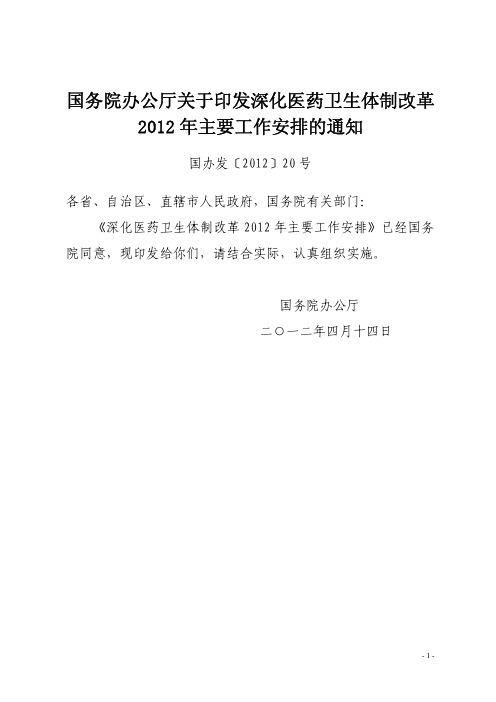
国务院办公厅关于印发深化医药卫生体制改革2012年主要工作安排的通知国办发〔2012〕20号各省、自治区、直辖市人民政府,国务院有关部门:《深化医药卫生体制改革2012年主要工作安排》已经国务院同意,现印发给你们,请结合实际,认真组织实施。
国务院办公厅二○一二年四月十四日深化医药卫生体制改革2012年主要工作安排2012年是深化医药卫生体制改革(以下简称医改)承前启后的关键一年,也是全面实施“十二五”期间深化医药卫生体制改革规划暨实施方案的开局之年。
为明确任务目标,落实工作责任,巩固扩大医改成果,持续深入推进医改,现提出2012年医改主要工作安排如下:一、总体要求深入贯彻落实《中共中央国务院关于深化医药卫生体制改革的意见》(中发〔2009〕6号)和《国务院关于印发“十二五”期间深化医药卫生体制改革规划暨实施方案的通知》(国发〔2012〕11号)精神,以建设符合我国国情的基本医疗卫生制度为核心,坚持把基本医疗卫生制度作为公共产品向全民提供的核心理念,坚持保基本、强基层、建机制的基本原则,坚持预防为主、以农村为重点、中西医并重的方针,保持医改基本政策的连续性和稳定性,着力在加快健全全民医保体系、巩固完善基本药物制度和基层医疗卫生机构运行新机制、积极推进公立医院改革三个方面取得重点突破,统筹推进相关领域改革,保持医改良好势头,为实现“十二五”阶段性改革目标奠定坚实基础。
二、工作任务(一)加快健全全民医保体系。
巩固扩大基本医保覆盖面。
1.1.巩固扩大基本医保覆盖面。
职工基本医疗保险(以下简称职工医保)、城镇居民基本医疗保险(以下简称城镇居民医保)和新型农村合作医疗(以下简称新农合)三项基本医疗保险参保率稳定在95%。
重点做好农民工、非公有制经济组织从业人员、灵活就业人员以及学生、学龄前儿童和新生儿参保管理工作。
继续推进关闭破产企业退休人员和困难企业职工等困难群体参保工作。
(人力资源社会保障部、卫生部分别负责)继续提高基本医疗保障水平。
中国中药协会在京召开《关于深化医药卫生体制改革的意见(征求意见稿)》座谈会
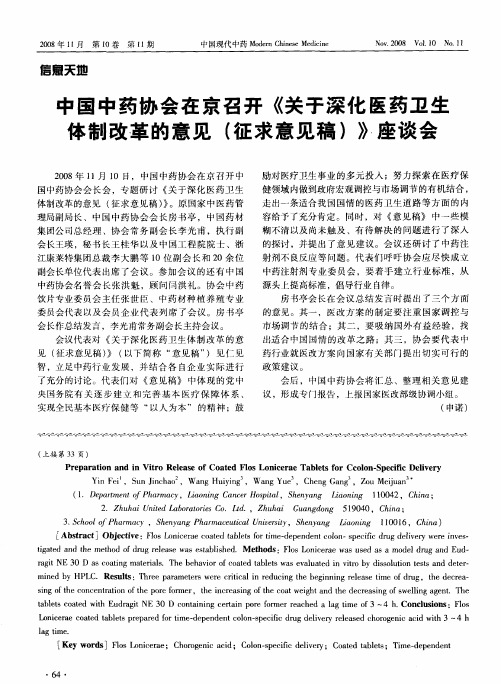
励对 医疗卫 生 事业 的 多元 投 人 ;努力 探 索 在 医疗保
国 中药协 会会 长 会 ,专题 研讨 《 于 深化 医 药卫 生 关 体制改革 的意见 ( 征求 意见 稿 ) 。原 国家 中 医药 管 》
理局副局 长 、中 国 中药 协会 会 长 房 书亭 ,中 国药材 集 团公 司总经 理 、协 会 常务 副 会 长李 光 甫 ,执 行 副 会长 王瑛 ,秘 书长 王 桂 华 以及 中国工 程 院 院 士 、浙
中药注射剂 专 业 委 员会 ,要 着 手建 立 行业 标 准 ,从
源 头上提 高标准 ,倡导行业 自律 。 房 书亭 会长 在会 议 总 结发 言 时 提 出 了三个 方 面 的意见 。其一 ,医 改方 案 的 制定 要 注重 国家 调控 与 市 场调 节 的结 合 ;其 二 ,要 吸 纳 国外 有益 经 验 ,找
会议 代表对 《 于深化 医 药卫 生体 制 改 革 的 意 关
见 ( 求意见稿 ) ( 征 》 以下 简 称 “ 意见 稿 ” )见 仁 见 智 ,立足 中药 行业 发展 ,并 结合 各 自企 业 实 际 进 行
出适 合 中国 国情 的 改革 之 路 ;其 三 ,协 会 要代 表 中
药 行业就 医改方 案 向 国家 有关 部 门提 出切 实可 行 的
江康莱 特集 团总裁 李 大 鹏等 l 副会 长 和 2 0位 O余 位 副会 长单 位代 表 出席 了会议 。参 加 会议 的还 有 中国
中药协会 名誉 会 长 张 洪魁 ,顾 问闫洪 礼 。协 会 中药 饮 片专业 委 员会 主任 张 世 臣 、中药 材种 植 养 殖 专业 委员会代 表 以及会 员企 业代 表 列 席 了会 议 。房 书 亭 会 长作 总结发 言 ,李光 甫常务 副ca u i h o ,WagH i n n n uy g ,WagY e ,C e gG n o i a i n u h n ag .Z uMe un j
深化医药卫生体制改革 新平县城乡居民基本医疗保障一体化工作显成效
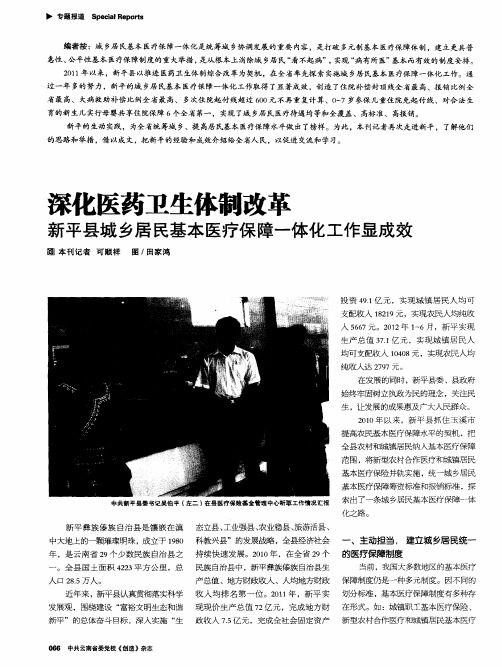
偿机 制的建 立和绩效考核 的深化 ,乡村 障制度 ,最大程度地满足 了城 乡居民医 费 用 9 6 . 元 ,报 销 6 1 . 3 28万 6 9 9万 元 , 4 医生 的工作积极性明显增强 ,医疗 卫生 疗保障需求 , 促进 了社会 公平 ,保障制 基 金 使 用 率为 8 .1 87%;县 乡两 级实 际
编者按 :城 乡居 民基本 医疗保障一体化是统筹城 乡协调发展 的重要 内容 ,是打破 多元制基本 医疗保 障体制 ,建立更具普 惠性 、 公平性基本 医疗保障制度的重大举措 , 是从根 本上消除城 乡居 民 “ 看不起 病”, 实现 “ 病有所 医” 基本 而有效的制度安排。 21 0 1年以来 ,新平县 以推进 医药卫 生体 制综合 改革 为契机 ,在全省率先探 索实施城 乡居民基本 医疗保 障一体化 工作 。通
时足额 兑现 各级财 政补助经费。从 2 1 00
一
体化 制度 , 从根 本上解决了城 乡医保 基 金到位 率 1 0 ;通过整合 ,可 用资 0%
年 5月 1日起 ,乡村医生补助 由原 来的 管理分割 、资源 分散 等给 城 乡居民带来 金 达 9 7 .9万 元 , 比 上 年 的 30 . 07 8 53 3 3
服务 质量 明显提高 。
度更具稳定性 、科学 性 , 持续 发展能力 住院报销比例达 8 . %。 O9 1
新 平 县城 乡居 民基 本 医疗 保 障一
基 层 医 疗 卫 生 机 构 发 展 速 度 进 一 体化 的探索 实践 ,体现 的是新 平县委政
每人每 月 10元提高 到 3 0 ,乡村医 诸多不便 的问题 , 乡居民参保积极 性 万元增加 了 2 倍 ;全县城 乡居民门诊 、 0 0元 城 . 6
国办函〔2009〕75号《国务院办公厅关于印发医药卫生体制五项重点改革2009年工作安排的通知》

国务院办公厅关于印发医药卫生体制五项重点改革2009年工作安排的通知国办函〔2009〕75号各省、自治区、直辖市人民政府,国务院各有关部门:《医药卫生体制五项重点改革2009年工作安排》(以下简称《工作安排》)已经国务院同意,现印发给你们,请结合实际,认真组织实施。
深化医药卫生体制改革是一项艰巨而复杂的工作,要明确方向,统筹规划,循序渐进,量力而行。
《工作安排》围绕医药卫生体制五项重点改革三年目标,抓住关键,突出重点,提出了2009年推进改革的10项任务,并明确了牵头部门。
各地区、各有关部门要加强领导,精心组织,进一步分解工作任务,细化工作安排,切实抓好落实。
国务院深化医药卫生体制改革领导小组办公室要加强对医改工作的统筹协调,指导和督促地方推进改革。
年底前,国务院深化医药卫生体制改革领导小组将对《工作安排》落实情况进行全面检查。
国务院办公厅二○○九年七月二十二日医药卫生体制五项重点改革2009年工作安排按照《中共中央国务院关于深化医药卫生体制改革的意见》(中发〔2009〕6号)和《国务院关于印发医药卫生体制改革近期重点实施方案(2009-2011年)的通知》(国发〔2009〕12号)精神,为切实推动改革,加强督促检查,确保开好局、起好步,现提出2009年医药卫生体制五项重点改革的工作安排。
一、加快推进基本医疗保障制度建设(一)扩大基本医疗保障覆盖面。
主要工作目标:1.城镇职工基本医疗保险(以下简称城镇职工医保)、城镇居民基本医疗保险(以下简称城镇居民医保)参保人数达到3.9亿人,比2008年增加7200万人。
做好城镇非公有制经济组织从业人员、大学生、灵活就业人员和农民工的参保工作。
(人力资源社会保障部负责)2.解决607万地方政策性关闭破产和依法破产国有企业、中央和中央下放地方政策性关闭破产国有企业退休人员的参保问题。
指导和督促地方解决其他破产企业退休人员和困难企业职工的参保问题。
(人力资源社会保障部负责)3.新型农村合作医疗(以下简称新农合)参保率稳定在90%以上。
陕西省人民政府办公厅关于印发陕西省深化医药卫生体制改革2010年有关工作督查验收办法的通知:陕西省深

建立完 善组 织 机 构 , 确工 作 方 式 。 由省 医 改 明 办 牵头 , 同省发 展改 革委 、 会 省监 察厅 、 省财 政厅 、 省 人 力资源社 会保 障厅 、 卫生厅 、 省 省食 品药 品监 管局 等部 门及抽 调专业 人员 组成 5个 省级 督查验 收工 作 小 组 ; 设 区市也 要 组 建相 应 的市 级 督查 验 收 工 作 各 小 组 。督查 验 收 采 取 听 取 汇 报 、 谈 问 卷 、 料 查 座 资
《 陕西省 深化 医药卫生 体制 改革 2 1 0 0年有 关 工作督 查验 收 办 法》已经省 政 府 同意 , 印发 给你 们 , 认 现 请
真 贯彻执 行 。
陕 西 省 人 民 政 府 办 公 厅
二 。 一 。年 十 月 三 十 一 日
陕西 省 深 化 医药 卫 生 体 制
改革 21 0 0年 有 关 工 作 督 查 验 收 办 法
ZHENG FU 0 N G G BAO
陕西省人 民政府办 公厅 关于 印发 陕 西 省 深 化 医 药 卫 生体 制 改 革 21 0 0年有关工作 督查验 收办法 的通 知
陕政 办发 [ 0 0 1 2 1 ]13号
各 设 区 市 人 民政 府 , 人 民 政 府 各 工 作 部 门 、 直 属 机 构 : 省 各
省级 督 查 时 间为 2 1 0 0年 l 2月 1 日至 3 日。 0 1
会 议 由 省 医 改 办 会 同 省 卫 生 厅 筹 备 , 励 资 金 奖
施 步 骤和 进展 情况 等 。
开展 药品 “ 三统 一 ” 启 动 卫 生管 理 县 镇 一 体 化 、
改 革 和 县 级 公 立 医 院 综 合 改 革 试 点 、 镇 卫 生 院 内 乡
深化医药卫生体制改革领导小组办公室文件
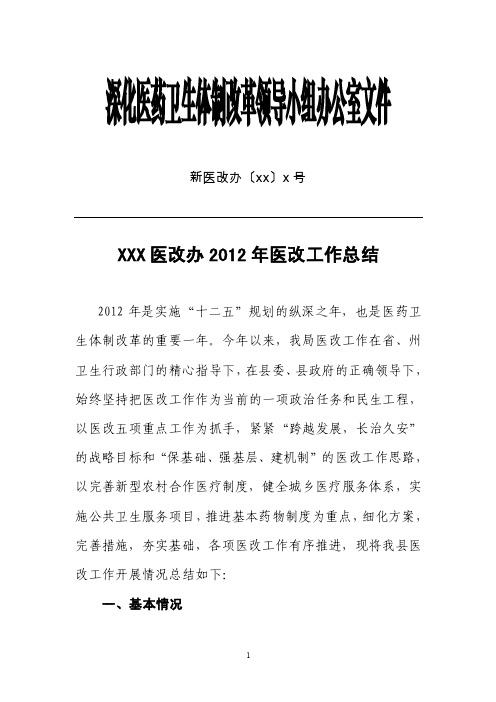
深化医药卫生体制改革领导小组办公室文件新医改办〔xx〕x号XXX医改办2012年医改工作总结2012年是实施“十二五”规划的纵深之年,也是医药卫生体制改革的重要一年。
今年以来,我局医改工作在省、州卫生行政部门的精心指导下,在县委、县政府的正确领导下,始终坚持把医改工作作为当前的一项政治任务和民生工程,以医改五项重点工作为抓手,紧紧“跨越发展,长治久安”的战略目标和“保基础、强基层、建机制”的医改工作思路,以完善新型农村合作医疗制度,健全城乡医疗服务体系,实施公共卫生服务项目,推进基本药物制度为重点,细化方案,完善措施,夯实基础,各项医改工作有序推进,现将我县医改工作开展情况总结如下:一、基本情况我县共有各级医疗卫生机构26所,其中,县级医疗卫生机构5所(县人民医院、县疾控中心、县中藏医院、县妇幼保健院、县计生指导服务站),乡、镇卫生院21所,村医医疗室97所,全县卫生系统共有人员275个。
从人员职业类别来看,卫生专业技术人员251人,占91%;工人及工勤人员12人,占4%;公务员及参公人员12人,占5%。
从人员分布单位来看,在县局本部工作10人,占3.6%;县级医疗单位120人,占43.6%;在乡、镇卫生单位工作145人,占52.8%。
从卫生专业技术职称构成上看,高级职称6人,占2%;中级职称27人,占10%;初级职称75人,占27%;未定职称154人,占61%。
二、医改工作采取的主要措施(一)加强领导,努力推进医改工作县委、县政府高度重视医改工作,为确保医改工作顺利实施,成立了以县政府常务副县长为组长,分管领导为副组长,卫生、发改、财政、人社等相关部门为成员的深化医疗卫生体制改革工作领导小组,积极研究突出问题,协调推进重点工作,形成了“政府领导,部门协作,医疗卫生机构配合”的联动机制,为深化改革提供了强有力的组织保障,全力做好医改工作。
(二)建章立制,健全绩效考核制度一是建立健全了基层医疗卫生机构及医务人员实施综合量化考核机制,制定下发了《新龙县卫生事业单位工作人员绩效考核办法(试行)》,并于年底12月前积极组织人员对我县医疗卫生服务实施情况进行全面考核,根据考核结果测算了绩效资金。
- 1、下载文档前请自行甄别文档内容的完整性,平台不提供额外的编辑、内容补充、找答案等附加服务。
- 2、"仅部分预览"的文档,不可在线预览部分如存在完整性等问题,可反馈申请退款(可完整预览的文档不适用该条件!)。
- 3、如文档侵犯您的权益,请联系客服反馈,我们会尽快为您处理(人工客服工作时间:9:00-18:30)。
医疗改革的内容
深化医药卫生体制改革。
统筹推进医疗保障、医疗服务、公共卫生、药品供应、
监管体制综合改革。
深化基层医疗卫生机构综合改革,健全网络化城乡基层医疗卫生服务运行机制。
加快公立医院改革,落实政府责任,建立科学的医疗绩效评价机制和适应行业特点的人才培养、人事薪酬制度。
完善合理分级诊疗模式,建立社区医生和居民契约服务关系。
充分利用信息化手段,促进优质医疗资源纵向流动。
加强区域公共卫生服务资源整合。
取消以药补医,理顺医药价格,建立科
学补偿机制。
改革医保支付方式,健全全民医保体系。
加快健全重特大疾病医疗保险和救助制度。
完善中医药事业发展政策和机制。
鼓励社会办医,优先支持举办非营利性医疗机构。
社会资金可直接投向资源稀缺及满足多元需求服务领域,多种形式参与公立医院改制重组。
允许医师多点执业,允许民办医疗机构纳入医保定点范围。
坚持计划生育的基本国策,启动实施一方是独生子女的夫妇可生育两个孩子的政策,逐步调整完善生育政策,促进人口长期均衡发展。
公告提出要深化医药卫生体制改革,深化医卫改革医疗器械股潜力大.记者注意到,公报指出,要健全促进就业创业体制机制,形成合理有序的收入分配格局,建立更加公平可持续的社会保障制度,深化医药卫生体制改革.实际上,今年7月,国务院办公厅就印发了关于《深化医药卫生体制改革2013年主要工作安排》的通知,要求着力加快健全全民医保体系,巩固完善基本药物制度和基层医疗卫生机构运行新机制,积极推进公立医院改革,统筹做好基本公共卫生服务均等化、医疗卫生资源配置、社会资本办医、医疗卫生信息化、药品生产流通和医
药卫生监管体制等方面的配套改革,巩固已有成果,在重点领域和关键环节取得新突破.对此,安信证券表示,2013年的医改工作安排,一方面强调将继续加大
国家投入,一方面强调要推进基药制度、改革医保支付方式、完善药品价格形成机制、推进公立医院改革,目的是保持医疗支付能力的可持续性。
该券商认为,
未来普通仿制药价格将下降,创新药市场导入速度将加快,独家基药会继续受益,医疗服务、医疗器械受政策扰动较小,发展潜力大.
1.逐步取消医院的行政级别
《全文》第四项第15条指出,加快事业单位分类改革,加大政府购买公共服
务力度,推动公办事业单位与主管部门理顺关系和去行政化,创造条件,逐步取消学校、科研院所、医院等单位的行政级别。
建立事业单位法人治理结构,推进
有条件的事业单位转为企业或社会组织。
建立各类事业单位统一登记管理制。
2.再提多点执业,促进优质医疗资源纵向流动
《全文》第十二项第46条提出,要深化医药卫生体制改革。
统筹推进医疗保障、医疗服务、公共卫生、药品供应、监管体制综合改革。
深化基层医疗卫生机
构综合改革,健全网络化城乡基层医疗卫生服务运行机制。
加快公立医院改革,
落实政府责任,建立科学的医疗绩效评价机制和适应行业特点的人才培养、人事薪酬制度。
完善合理分级诊疗模式,建立社区医生和居民契约服务关系。
充分利用信息化手段,促进优质医疗资源纵向流动。
加强区域公共卫生服务资源整合。
取消以药补医,理顺医药价格,建立科学补偿机制。
改革医保支付方式,健全全
民医保体系。
加快健全重特大疾病医疗保险和救助制度。
完善中医药事业发展政策和机制。
并指出要鼓励社会办医,优先支持举办非营利性医疗机构。
社会资金可直接投向资源稀缺及满足多元需求服务领域,多种形式参与公立医院改制重
组。
允许医师多点执业,允许民办医疗机构纳入医保定点范围。
解读十八届三中全会:八大创新全面推进医改
核心提示:在党的十八届三中全会上,针对医改的持续深入提出要求。
而十八届三中全会与十四届三中全会、十六届三中全会相比,更多了不少其独有的特点。
在2013全国药品流通行业年会上,国务院医改专家咨询委员会委员、北大中国经济研究中心教授李玲针对十八届三中全会八大创新进行了分享。
11月12日,中国共产党第十八届中央委员会第三次全体会议(十八届三中全会)胜利闭
幕,明确了全面深化改革的总目标、总任务等,15日发布《中共中央关于全面深化改革若干
重大问题的决定》,《决定》指出要深化医药卫生体制改革。
深化医药卫生体制改革,统筹推进医疗保障、医疗服务、公共卫生、药品供应、监管体制
综合改革。
包括深化基层医疗制度改革与加快公立医院改革,健全网络化城乡基层医疗卫生
服务运行机制,建立科学的医疗绩效评价机制和适应行业特点的人才培养、人事薪酬制度。
取消以药补医,理顺医药价格,建立科学补偿机制。
改革医保支付方式,健全全民医保体系。
2013年已经是医改第十年,也是新医改第五个年头,医疗行业中普遍认为医改进入深水区。
在医改开始撼动医疗行业各方既有利益之时,医改显得寸步难行。
在党的十八届三中全会上,针对医改的持续深入提出要求。
而十八届三中全会与十四届三中全会、十六届三中全会相比,更多了不少其独有的特点。
在2013全国药品流通行业年会上,国务院医改专家咨询委员会委员、北大中国经济研究中心教授李玲针对十八届三中全会八大创新进行了分享。
创新之一:明确了改革目标和价值取向。
李玲表示:“我们过去的改革往往是一个领域或者一个环节的改革,本次三中全会的改革则是全社会的。
价值取向以提高公平正义、提高百姓福祉为出发点和落脚点。
中国经济发展取得巨大成效,而老百姓却对收入、各方面保障的差距和不公平性产生不满。
”强化国家能力成为今后改革的主要目标,而医疗卫生制度是现代国家制度的重要组成部分,医疗卫生领域的问题最凸显国家治理能力。
创新之二:市场起决定性作用和政府更好发挥作用。
尽管一直以来强调经济依靠两只手——“市场需求”和“政府宏观调控”,但一直以
来,政府过度介入市场行为,成为市场行为推手导致医药卫生市场经济发展过度依赖国家政
策而缺少对市场需求的响应。
十八届三中全会则针对此要求放开政府宏观调控的手,尊重市场规律,而将职能定位于保持宏观经济稳定,加强和优化公共服务,保障公平竞争,加强市
场监管,维护市场秩序,推动可持续发展,促进共同富裕,弥补市场失灵。
这次决定是拓展
了政府行为的定义,政府的责任和作用更加明确。
“政府和市场这“两只手”如何良好合作
是非常重要的,”李玲表示。
创新之三:清晰区分五大改革的界限。
该创新主要针对过去片面强调经济改革、用经济改革的逻辑指导其他改革的惯性思维,
进行惯性思维及做法的打破和新思路的开拓。
与十四届三中全会与十六届三中全会相比,十。
